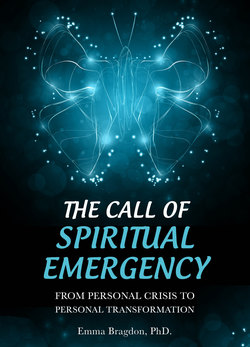Читать книгу The Call of Spiritual Emergency: From Personal Crisis to Personal Transformation - Emma Inc. Bragdon - Страница 6
На сайте Литреса книга снята с продажи.
Historical Perspective on Spiritual Emergency
ОглавлениеThe term spiritual emergency was coined by Christina and Stanislav Grof, M.D. The concept of spiritual emergency grew out of Dr. Grof's research in non-ordinary states of consciousness in a clinical context as well as Christina's personal experiences and work with other people.
Together the Grofs have been exploring the mysteries of spiritual growth, articulating the patterns in which it unfolds, and developing psychotherapeutic modalities to encourage spiritual opening. They found themselves paying particular attention to the needs of people who had spontaneous, unexpected spiritual openings in social contexts which were unsympathetic and unsupportive. Many of these people had no guidance, no encouragement, no companionship, no conceptual framework to help them find their way in integrating these experiences in a healthful manner. Christina Grof founded the Spiritual Emergency Network at Esalen Institute in Big Sur, California, in 1980 as a referral service to assist such people in finding supportive counselors and friends who were prepared to help them integrate spiritual awakening phenomena. At its inception a few work-scholars came each month to train with the Grofs. Together they collected referral names and addresses, produced educational materials, started a library, and published a newsletter.
In 1985, the Spiritual Emergency Network was moved to the Institute of Transpersonal Psychology in Menlo Park, California. Shortly after the move, the name was changed to the Spiritual Emergence Network (SEN) in order to emphasize support of the whole process of spiritual emergence and not only the crises of dramatic transition points. Since 1985, the Spiritual Emergence Network has branched out, and now offers educational workshops, lectures, and conferences to the public, and sponsors the publication of a newsletter, journal and educational materials, as well as continuing to expand its networking.
There are now over forty regional centers throughout the world, providing educational materials and referrals to people who seek this specialized support service. The Grofs travel worldwide, educating people about spiritual awakening phenomena and the Spiritual Emergence Network, as well as continuing their writing and conducting a training program for certification in helping people in spiritual emergency.
My own role at the Spiritual Emergence Network is in writing educational materials, including editing the Spiritual Emergence Network Journal. I also teach workshops about the field of spiritual emergence/emergency based on my first book, A Sourcebook for Helping People in Spiritual Emergency. The Sourcebook synthesizes the seminal work of the Grofs and other leaders in the field of transpersonal psychology with my own perspective. I have been involved with Eastern yogas, shamanism, and transpersonal psychology for twenty-five years. During this time, I have lived within several spiritual communities and worked as a Neo-Reichian therapist. My intimate involvement with the intricacies of spiritual development in myself and others has made me particularly aware of the dovetailing of spiritual and psychological growth.
What does this close relationship between spiritual and psychological growth mean in terms of spiritual emergence? It means that we cannot move forward spiritually unless we are also willing to deal completely with our personal psychology, especially developmental issues from early childhood that pattern the way we perceive and react to the present. In the first half of this century, Wilhelm Reich, M.D., in his study of body psychology, and Carl Jung, M.D., in focusing on wholeness and the quest for meaning, each supported this theory. Various ancient esoteric traditions throughout the world have been built on this premise. More recently, Stanislav Grof, M.D., Ken Wilber, and other theoreticians have tied this idea to the psychology of transformation and the thrust of human evolution.
This book brings these theories close to home, helping to demystify an area of experience often seen as alien or academic. Stories volunteered from my clients and members of spiritual communities, all ordinary people, expand our understanding of the stresses in our world that pull increasing numbers of individuals toward spiritual emergence. Transpersonal experiences can happen to anyone—a child, an adolescent, an adult, young or old. These experiences can happen spontaneously or with intention. They can happen anywhere: on a mountainside, in a therapy office, in church, in bed. They can catalyze feelings of deep peace or ecstasy. Perhaps some of us have these experiences quite often; but unless we have a name for them, they often pass us by unrecognized.
Ultimately, it is the responsibility of our institutions, especially our religious and medical establishments, to accommodate the needs of the public. Social service institutions are currently in a period of transformation, making changes in structure to respond to new needs. Special facilities in hospitals set aside for hospice care and natural childbirth are two examples of recent changes. It is now time for us to make organizational changes to more gracefully support spiritual emergence during the critical processes that carry us beyond the conventional norms of human development. Suggestions for this are included in this book. Realizing these institutional changes is the current goal for many of us involved with helping people in spiritual emergency.
